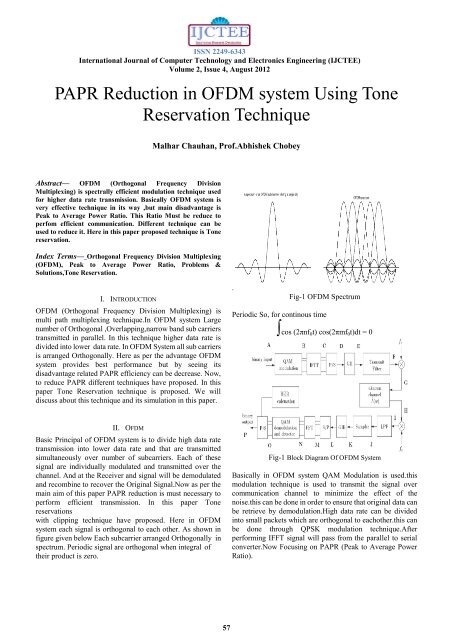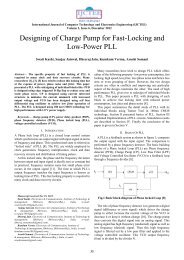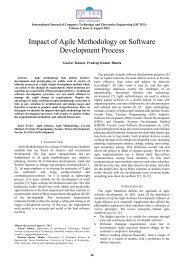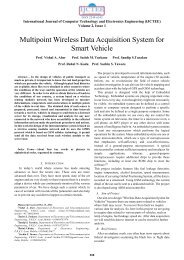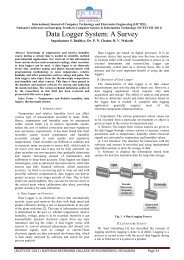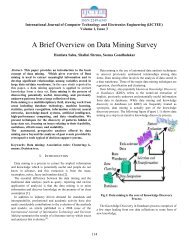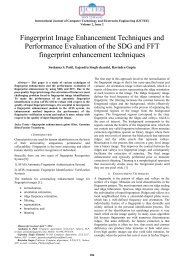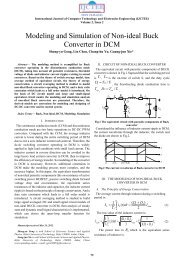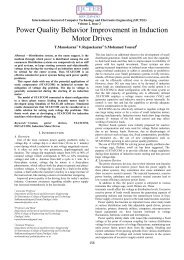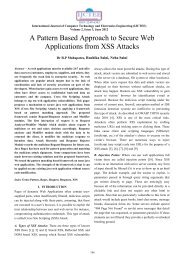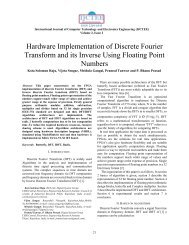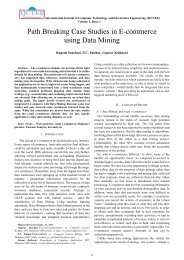PAPR Reduction in OFDM system Using Tone Reservation Technique
PAPR Reduction in OFDM system Using Tone Reservation Technique
PAPR Reduction in OFDM system Using Tone Reservation Technique
You also want an ePaper? Increase the reach of your titles
YUMPU automatically turns print PDFs into web optimized ePapers that Google loves.
ISSN 2249-6343<br />
International Journal of Computer Technology and Electronics Eng<strong>in</strong>eer<strong>in</strong>g (IJCTEE)<br />
Volume 2, Issue 4, August 2012<br />
<strong>PAPR</strong> <strong>Reduction</strong> <strong>in</strong> <strong>OFDM</strong> <strong>system</strong> Us<strong>in</strong>g <strong>Tone</strong><br />
<strong>Reservation</strong> <strong>Technique</strong><br />
Malhar Chauhan, Prof.Abhishek Chobey<br />
<br />
Abstract— <strong>OFDM</strong> (Orthogonal Frequency Division<br />
Multiplex<strong>in</strong>g) is spectrally efficient modulation technique used<br />
for higher data rate transmission. Basically <strong>OFDM</strong> <strong>system</strong> is<br />
very effective technique <strong>in</strong> its way ,but ma<strong>in</strong> disadvantage is<br />
Peak to Average Power Ratio. This Ratio Must be reduce to<br />
perfom efficient communication. Different technique can be<br />
used to reduce it. Here <strong>in</strong> this paper proposed technique is <strong>Tone</strong><br />
reservation.<br />
Index Terms— Orthogonal Frequency Division Multiplex<strong>in</strong>g<br />
(<strong>OFDM</strong>), Peak to Average Power Ratio, Problems &<br />
Solutions,<strong>Tone</strong> <strong>Reservation</strong>.<br />
I. INTRODUCTION<br />
<strong>OFDM</strong> (Orthogonal Frequency Division Multiplex<strong>in</strong>g) is<br />
multi path multiplex<strong>in</strong>g technique.In <strong>OFDM</strong> <strong>system</strong> Large<br />
number of Orthogonal ,Overlapp<strong>in</strong>g,narrow band sub carriers<br />
transmitted <strong>in</strong> parallel. In this technique higher data rate is<br />
divided <strong>in</strong>to lower data rate. In <strong>OFDM</strong> System all sub carriers<br />
is arranged Orthogonally. Here as per the advantage <strong>OFDM</strong><br />
<strong>system</strong> provides best performance but by see<strong>in</strong>g its<br />
disadvantage related <strong>PAPR</strong> efficiency can be decrease. Now,<br />
to reduce <strong>PAPR</strong> different techniques have proposed. In this<br />
paper <strong>Tone</strong> <strong>Reservation</strong> technique is proposed. We will<br />
discuss about this technique and its simulation <strong>in</strong> this paper.<br />
.<br />
Fig-1 <strong>OFDM</strong> Spectrum<br />
Periodic So, for cont<strong>in</strong>ous time<br />
∫cos (2πnf 0 t) cos(2πmf 0 t)dt = 0<br />
II. <strong>OFDM</strong><br />
Basic Pr<strong>in</strong>cipal of <strong>OFDM</strong> <strong>system</strong> is to divide high data rate<br />
transmission <strong>in</strong>to lower data rate and that are transmitted<br />
simultaneously over number of subcarriers. Each of these<br />
signal are <strong>in</strong>dividually modulated and transmitted over the<br />
channel. And at the Receiver and signal will be demodulated<br />
and recomb<strong>in</strong>e to recover the Orig<strong>in</strong>al Signal.Now as per the<br />
ma<strong>in</strong> aim of this paper <strong>PAPR</strong> reduction is must necessary to<br />
perform efficient transmission. In this paper <strong>Tone</strong><br />
reservations<br />
with clipp<strong>in</strong>g technique have proposed. Here <strong>in</strong> <strong>OFDM</strong><br />
<strong>system</strong> each signal is orthogonal to each other. As shown <strong>in</strong><br />
figure given below Each subcarrier arranged Orthogonally <strong>in</strong><br />
spectrum. Periodic signal are orthogonal when <strong>in</strong>tegral of<br />
their product is zero.<br />
Fig-1 Block Diagram Of <strong>OFDM</strong> System<br />
Basically <strong>in</strong> <strong>OFDM</strong> <strong>system</strong> QAM Modulation is used.this<br />
modulation technique is used to transmit the signal over<br />
communication channel to m<strong>in</strong>imize the effect of the<br />
noise.this can be done <strong>in</strong> order to ensure that orig<strong>in</strong>al data can<br />
be retrieve by demodulation.High data rate can be divided<br />
<strong>in</strong>to small packets which are orthogonal to eachother.this can<br />
be done through QPSK modulation technique.After<br />
perform<strong>in</strong>g IFFT signal will pass from the parallel to serial<br />
converter.Now Focus<strong>in</strong>g on <strong>PAPR</strong> (Peak to Average Power<br />
Ratio).<br />
57
ISSN 2249-6343<br />
International Journal of Computer Technology and Electronics Eng<strong>in</strong>eer<strong>in</strong>g (IJCTEE)<br />
Volume 2, Issue 4, August 2012<br />
III. <strong>PAPR</strong> (PEAK TO AVERAGE POWER RATIO)<br />
Now here is the explanation of <strong>PAPR</strong> <strong>in</strong> Mathematical<br />
equation form. <strong>PAPR</strong> is def<strong>in</strong>ed as the maximum power<br />
occurr<strong>in</strong>g <strong>in</strong> the <strong>OFDM</strong> transmission to the average power of<br />
the <strong>OFDM</strong> transmission. Mathematical representation has<br />
been given below.<br />
<strong>PAPR</strong> = P peak = max [|x n | 2 ]<br />
P average E [|x n | 2 ]<br />
Where, P peak = Peak power of the <strong>OFDM</strong> <strong>system</strong><br />
P average = average power of the <strong>OFDM</strong> <strong>system</strong>.<br />
E [・] is the expectation operator<br />
The <strong>PAPR</strong> of an oversampled version of x (t) calculated<br />
as per the above equation (1). Here <strong>in</strong> this equation our ma<strong>in</strong><br />
goal is to m<strong>in</strong>imize the max [|X n | 2 ].<br />
Fig.3 <strong>OFDM</strong> signal conta<strong>in</strong><strong>in</strong>g s<strong>in</strong>usoidal high peaks<br />
In basics of <strong>OFDM</strong> (Orthogonal frequency division<br />
multiplex<strong>in</strong>g) has been discussed .actually <strong>OFDM</strong> <strong>system</strong> is<br />
very efficient & marvelous technique <strong>in</strong> its manner, but when<br />
there is a merits demerits also available. So here we discuss<br />
one of the major drawbacks of the <strong>OFDM</strong> <strong>system</strong>. Drawback<br />
is high <strong>PAPR</strong> (Peak-to-Average Power ratio). <strong>PAPR</strong> means<br />
randomly s<strong>in</strong>usoidal leads occurred dur<strong>in</strong>g transmission of the<br />
<strong>OFDM</strong> signal. So <strong>in</strong> this chapter we discuss basics of <strong>PAPR</strong>,<br />
why it is created & what the proposed solution are for reduce<br />
it. Now <strong>in</strong> Fig. 3 as per expla<strong>in</strong>ed above high s<strong>in</strong>usoidal peak<br />
is shown clearly. So we can understand by see<strong>in</strong>g it what is it.<br />
Signal is transmitted with the sdata = 64 data symbol per<br />
frame to IFFT. Now here <strong>in</strong> Fig.4 orig<strong>in</strong>al <strong>PAPR</strong> is displayed.<br />
And power value is 10dB. So this much power level is high<br />
for transmitt<strong>in</strong>g <strong>OFDM</strong> signal. So it conta<strong>in</strong> more power.<br />
Here power level of <strong>PAPR</strong> is must <strong>PAPR</strong>><strong>PAPR</strong>0<br />
Fig.4 Orig<strong>in</strong>al <strong>PAPR</strong><br />
In this paper ma<strong>in</strong> Aim is to reduce the <strong>PAPR</strong> from 10db level<br />
to less level so by that performance can be improved. So as<br />
per the <strong>in</strong>troduction of <strong>PAPR</strong> we can judge that to reduce the<br />
<strong>PAPR</strong> is most important po<strong>in</strong>t <strong>in</strong> the <strong>OFDM</strong> <strong>system</strong>. Because<br />
of when we are talk<strong>in</strong>g about the high speed data<br />
communication <strong>in</strong> real life like video call<strong>in</strong>g, high speed<br />
<strong>in</strong>ternet access, and also ma<strong>in</strong> po<strong>in</strong>t is that high speed data<br />
access up to 2mbps while mov<strong>in</strong>g on the vehicle at 100km/h, ,<br />
Microwave terrestrial television, Digital audio broadcast<strong>in</strong>g<br />
(DAB), 4G <strong>system</strong>, hyper LAN. So this most type of<br />
communication <strong>system</strong>s required high data rate. But problem<br />
occurs like <strong>PAPR</strong> <strong>in</strong> <strong>OFDM</strong> <strong>system</strong> prevent these types of<br />
facilities <strong>in</strong> the real life. So to reduce it is most important.<br />
This is the simulation of <strong>OFDM</strong> <strong>system</strong> to observe <strong>PAPR</strong> <strong>in</strong> it.<br />
So this is the basic explanation about <strong>PAPR</strong> and why it is<br />
reduce <strong>in</strong> <strong>OFDM</strong> <strong>system</strong>. Now there are different techniques<br />
has been proposed for the reduc<strong>in</strong>g <strong>PAPR</strong> <strong>in</strong> <strong>OFDM</strong> <strong>system</strong>.<br />
<strong>Tone</strong> <strong>Reservation</strong><br />
IV. PROPOSED TECHNIQUE<br />
This technique <strong>in</strong>cludes no of set of reservation of tones. By<br />
us<strong>in</strong>g this technique reserved tones can be used to m<strong>in</strong>imize<br />
the <strong>PAPR</strong>.this method is used for multicarrier transmission<br />
and also shows the reserv<strong>in</strong>g tones to reduce the <strong>PAPR</strong>.this<br />
technique is depend on amount of complexity.when there is<br />
number of tones is small rduction <strong>in</strong> <strong>PAPR</strong> may represent non<br />
negligible samples of available bandwidth.advantage of this<br />
tone reservation is very positive that no process is needed at<br />
receiver end. And also do not need to transmit the side<br />
<strong>in</strong>formation along with the transmitted signal. In this<br />
technique no of loop is used .and the signal will pass from<br />
each loop. And depend<strong>in</strong>g no of iterate the output <strong>PAPR</strong><br />
value will be displayed.<br />
58
ISSN 2249-6343<br />
International Journal of Computer Technology and Electronics Eng<strong>in</strong>eer<strong>in</strong>g (IJCTEE)<br />
Volume 2, Issue 4, August 2012<br />
Now as per shown the fig.6 this is the simulation result by<br />
us<strong>in</strong>g the tone reservation technique to reduce the <strong>PAPR</strong>. This<br />
proposed technique <strong>in</strong>cludes signal power & mean power .<br />
Now <strong>in</strong> this technique <strong>OFDM</strong> signal is transmitted after<br />
perform IFFT .<br />
X=IFFT(X*TR)*√ N<br />
Here as per the signal power and comb<strong>in</strong>ation of mean power<br />
and CR. <strong>Reduction</strong> <strong>in</strong> <strong>PAPR</strong> has been possible.<br />
Fig.5 shows <strong>PAPR</strong> reduction up to 1.5 dB<br />
As per the technique above fig shows the previous simulation<br />
by keep<strong>in</strong>g CR= 1, that why reduction <strong>in</strong> the <strong>PAPR</strong> can be<br />
done up to 1.5dB only but the times always wants some<br />
changes so by this technique due to some changes better<br />
result can be display. In table the data shows reduction <strong>in</strong><br />
CCDF of <strong>PAPR</strong>.<br />
Table-1 Data of <strong>Reduction</strong> <strong>in</strong> CCDF for M=32<br />
CCDF_X =<br />
Columns 1 through 16<br />
1.0000 1.0000 1.0000 0.9980 0.9940<br />
0.9740 0.9230 0.8440 0.7430 0.6270 0.5080<br />
0.3800 0.2710 0.1870 0.1280 0.0820<br />
Columns 17 through 31<br />
0.0560 0.0350 0.0190 0.0110 0.0070<br />
0.0030 0.0010 0 0 0 0 0 0<br />
0 0<br />
The signal generated <strong>in</strong> BPSK modulation.signal then signal<br />
passed from 1000 loops.<strong>OFDM</strong> signal’s peaks can be remove<br />
at some level by us<strong>in</strong>g this technique. In this technique by<br />
us<strong>in</strong>g previous reservation terms further can be evaluate.<br />
Table-2 Data of <strong>Reduction</strong> <strong>in</strong> CCDF for M=32<br />
CCDF_X =<br />
Columns 1 through 16<br />
1.0000 1.0000 1.0000 1.0000 1.0000 1.0000<br />
1.0000 1.0000 1.0000 0.9990 0.9970 0.9890<br />
0.9720 0.9330 0.8820 0.8280<br />
Columns 17 through 31<br />
0.7470 0.6640 0.5800 0.4880 0.3970 0.3190<br />
0.2460 0.1760 0.1260 0.0940 0.0580 0.0410<br />
0.0330 0.0170 0.0110<br />
Fig.6 shows <strong>PAPR</strong> reduction up to 2 dB<br />
Clipp<strong>in</strong>g Ratio (CR) = 2<br />
Here particular <strong>in</strong> this technique loop is 1000. And the<br />
reduce<strong>in</strong>g of data we can see here it is cont<strong>in</strong>uous decreas<strong>in</strong>g.<br />
The value of CCDF is checked for 32 Times because here<br />
M=32.<br />
V. CONCLUSION<br />
As per the data of paper and the simulation result the<br />
simulated graph shows that the technique that proposed<br />
named tone reservation has affected at some level that we<br />
can show easily <strong>in</strong> the fig.6 graph. Basically this type of<br />
simulation will be helpful for the future of <strong>OFDM</strong> <strong>system</strong>.<br />
Actually day by day due to improvement of technology <strong>in</strong><br />
the field of communication this type of improvement will<br />
widely hepful.<br />
REFERENCES<br />
[1] V. Vijayarangan, Dr. (Mrs) R. Sukanesh , “An Overview Of<br />
<strong>Technique</strong>s For Reduc<strong>in</strong>g Peak to Average Power Ratio And Its<br />
Selection Criteria For Orthogonal Frequency<br />
Divisionmultiplex<strong>in</strong>g Radio Systems” Journal Of Theoretical<br />
And Applied Information Technology,Year 2009 ,Vol-5, No-5,<br />
E- Issn- 1817-3195/Issn-1992-8645<br />
59
ISSN 2249-6343<br />
International Journal of Computer Technology and Electronics Eng<strong>in</strong>eer<strong>in</strong>g (IJCTEE)<br />
Volume 2, Issue 4, August 2012<br />
[2] Umar Izaz Butt, “A Study On <strong>Tone</strong> <strong>Reservation</strong> <strong>Technique</strong> For<br />
Papr <strong>Reduction</strong> In Ofdm” Year 2010 Dissertation .Com Boca<br />
Raton, Florida ISBN-10:1-59942-360-X, ISBN-13:<br />
978-1-59942-360-9<br />
[3] Malhar chauhan,Saurabh patel,Hardik patel “ Different<br />
<strong>Technique</strong>s to Reduce the <strong>PAPR</strong> <strong>in</strong> <strong>OFDM</strong> System” year 2012,<br />
International Journal of Eng<strong>in</strong>eer<strong>in</strong>g Research andApplications<br />
(IJERA) ISSN: 2248-9622, Vol. 2, Issue 3<br />
Thesis:<br />
[1] Mohammad Zavid Parvez Md. Abdullah Al Baki “Peak To<br />
Average Power Ratio (Papr) <strong>Reduction</strong> In Ofdm Based Radio<br />
Systems”, Master Of Science Thesis Blek<strong>in</strong>ge Institute Of<br />
Technology May 2010.<br />
[2] Abhishek Arun Dash “Ofdm Systems and Papr <strong>Reduction</strong><br />
<strong>Technique</strong>s <strong>in</strong> Ofdm Systems”, Bachelor Thesis, Department Of<br />
Electronics and Communication Eng<strong>in</strong>ner<strong>in</strong>g National Institute<br />
of Technology, Rourkela 2006 – 2010.<br />
[3] A.H.M Shahparan “Numarical Performance Evalution Of Papr<br />
<strong>Reduction</strong> In Mimo Ofdm Wireless Communication” Thesis Of<br />
Bachelor Of Science Department Computer Science &<br />
Telecommunication Eng<strong>in</strong>eer<strong>in</strong>g, Noakhali Science<br />
Technological University,Sonapur.Nov-2011<br />
AUTHOR‟S PROFILE:-<br />
Malhar Chauhan1 F<strong>in</strong>al Mtech Student<br />
Dept of E.C.E, RKDF Institute Of Technology ,Bhopal,India.<br />
Prof.Abhishek Chobey2 Professor<br />
Dept of E.C.E, RKDF Institute Of Technology ,Bhopal,India.<br />
60


